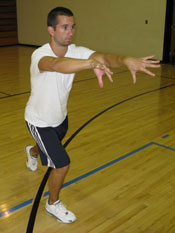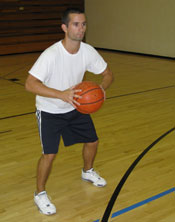Basketball
"Practice does not make perfect. Only perfect practice makes perfect" - Vince Lombardi
As we are entering our 3rd or 4th lesson of Basketball, I felt it would help your learning if I detailed some of the most important skills that we have learned so far so you can do some "perfect practice". In this blog post, you will find explanations through text and video of the dribble, pass and lay-up.
The Dribble
Dribbling is one of the most fundamental skills that must be learned. Not only is it important to learn how to dribble well, but it is important to know when, and when not, to dribble. One player who over-dribbles can kill a team's offensive motion and momentum. To become a good dribbler and ball handler, you must practice dribbling as often as you can, using both hands.You may dribble:
1. To advance the ball up the court.
2. To drive to the hoop to score.
3. To get open for a shot.
4. To open up a passing lane, to have a better chance of completing a pass.
5. To get out of a trap.
6. To kill the clock at the end of a game.
Take a look at this video to see a professional teach you how to dribble.
The Chest and Bounce Pass
Passing is also fundamental to the game of basketball. This is because it is a team sport, meaning you must use each other to achieve a common goal, i.e. winning. Here are some points to consider about passing in basketball;
- A good pass is a pass a teammate can catch
- When passing, step toward your receiver.
- When catching, step toward the pass
- Like shooting, the ball should have a backspin to it. This is accomplished by following through on every pass.
CHEST PASS
 The chest pass is named so because the pass originates from the chest. It is thrown by gripping the ball on the sides with the thumbs directly behind the ball. When the pass is thrown, the fingers are rotated behind the ball and the thumbs are turned down. The resulting follow through has the back of the hands facing one another with the thumbs straight down. The ball should have a nice backspin.
The chest pass is named so because the pass originates from the chest. It is thrown by gripping the ball on the sides with the thumbs directly behind the ball. When the pass is thrown, the fingers are rotated behind the ball and the thumbs are turned down. The resulting follow through has the back of the hands facing one another with the thumbs straight down. The ball should have a nice backspin.When throwing a chest pass, the players should strive to throw it to the receiver's chest level. Passes that go low to high or high to low are difficult to catch.
BOUNCE PASS
The bounce pass is thrown with the same motion however it is aimed at the floor. It should be thrown far enough out that the ball bounces waist high to the receiver. Some say try to throw it 3/4 of the way to the receiver, and that may be a good reference point to start, but each player has to experiment how far to throw it so it bounces to the receiver properly. Putting a proper and consistent backspin on the pass will make the distance easier to judge.
Here is a video that shows the different forms of passing as shown by a professional.
The lay-up
The lay-up is the easiest shot and the first shot you should learn. It's not as easy as it looks at first, as a lot of kids have difficulty getting the correct footwork, and shooting off the correct foot.When dribbling toward the basket, move slightly to one side of the hoop to create the proper angle. If you're on the right side, dribble right-handed, and plant your left (inside) foot and jump off that foot, and finally shoot with your right hand. As you raise your right hand, your right knee should also elevate. Pretend there is a string attached to your right hand and your right knee. Reverse this form if shooting from the left side.
As you approach the hoop, take a half step with your outside foot, then take a full stride with your inside foot pushing off the court. When jumping your outside knee should be bent. Go directly toward the basket, with your head up and eyes focused on the backboard. Go up strong and straight to the hoop. Don't shy away if there is a defender, just go strong to the hoop. You may get fouled and get a three point chance.





No comments:
Post a Comment